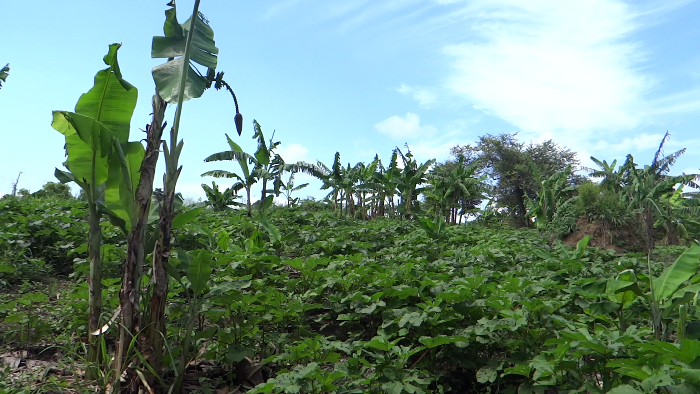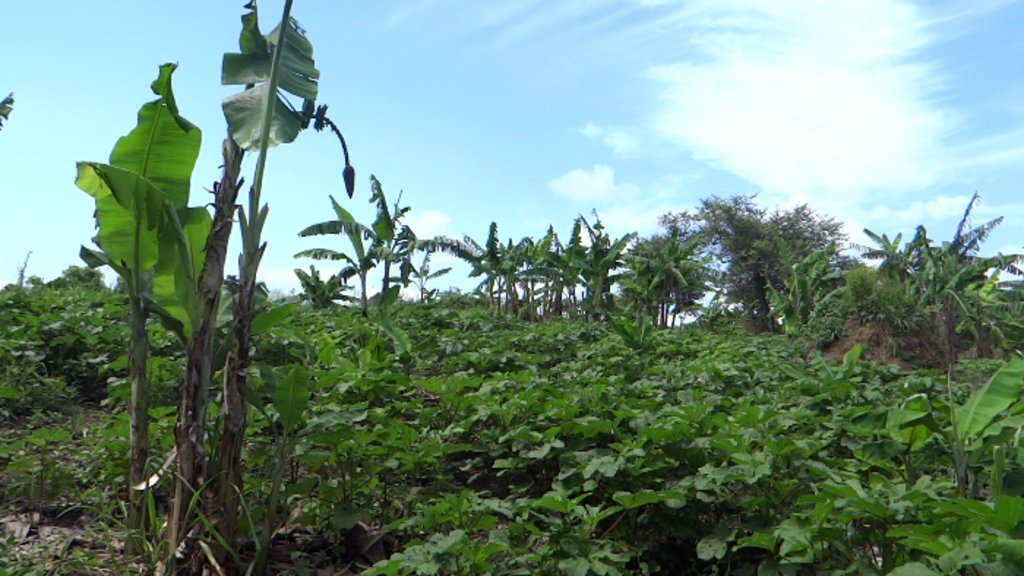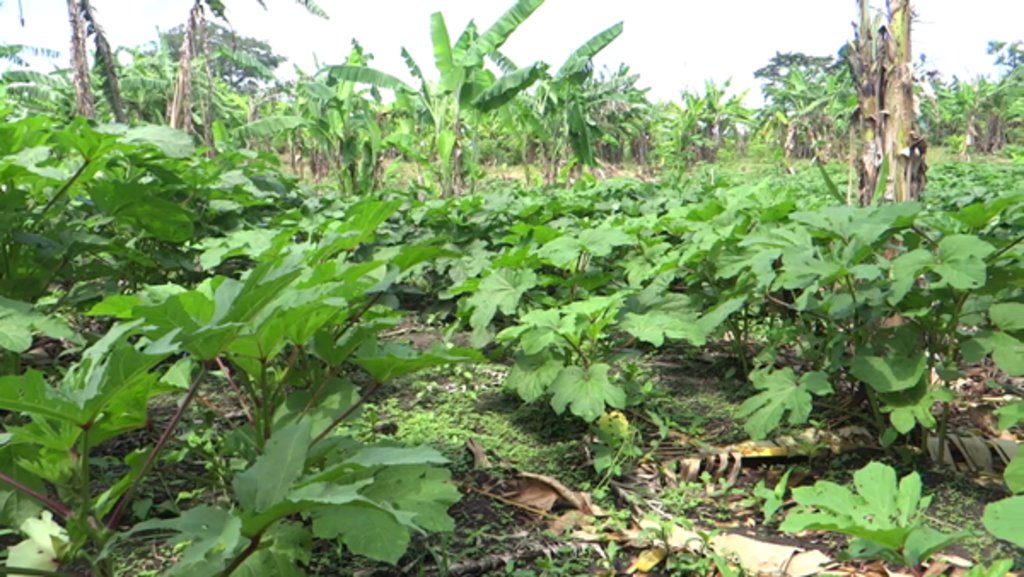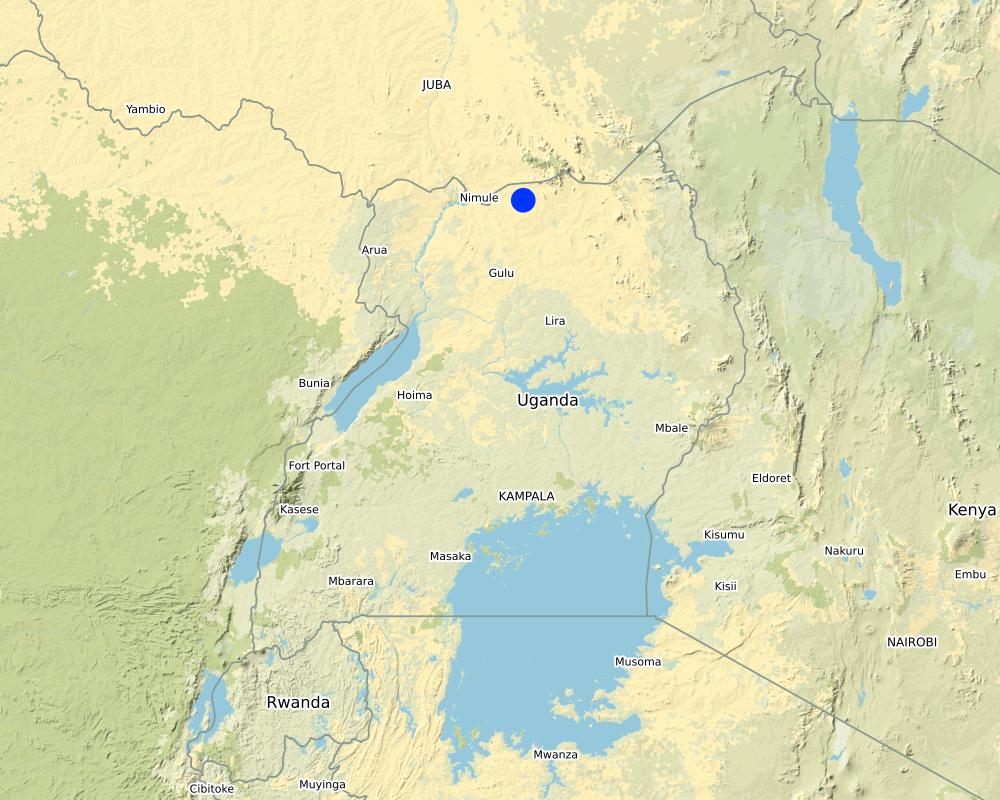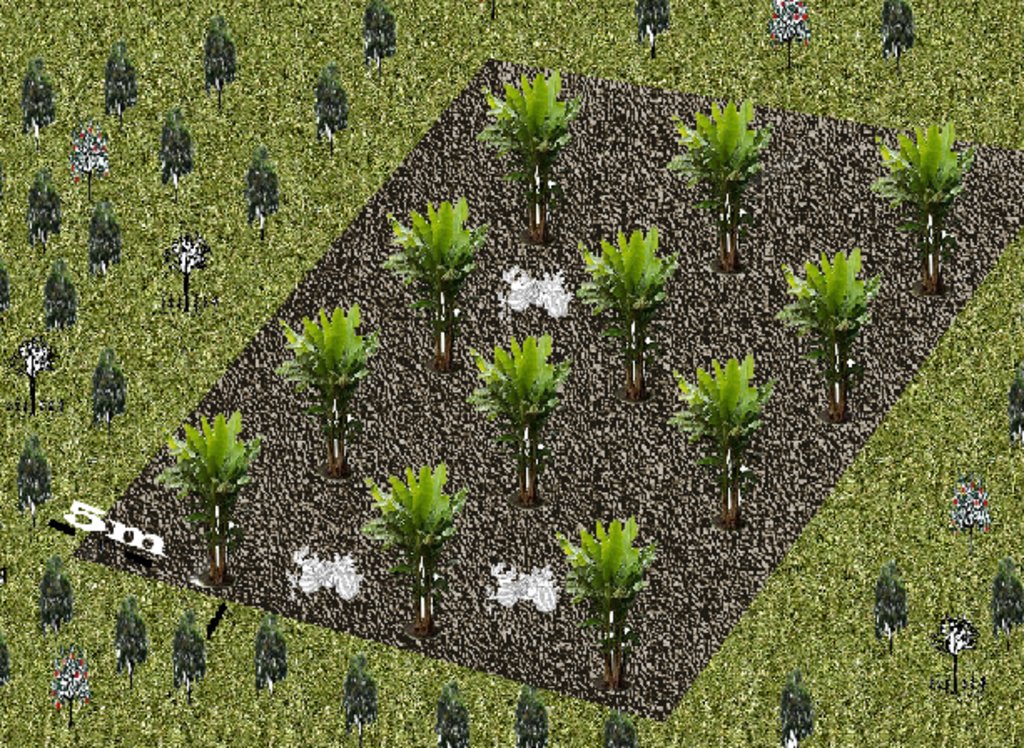Woodland-Protected Banana Cultivation for Increased Production and Household Income [乌干达]
- 创建:
- 更新:
- 编制者: Bernard Fungo
- 编辑者: JOY TUKAHIRWA, Kamugisha Rick Nelson, betty adoch, Sunday Balla Amale
- 审查者: John Stephen Tenywa, Udo Höggel
Pito Labolo ki pot dek
technologies_2839 - 乌干达
查看章节
全部展开 全部收起1. 一般信息
1.2 参与该技术评估和文件编制的资源人员和机构的联系方式
关键资源人
土地使用者:
Pkechocon Alex
+256712262059 / +256788945199
Palwong Parish, Paboo sub county
Palwong Parish, Pabbo Sub county, Amuru District
乌干达
有助于对技术进行记录/评估的项目名称(如相关)
Scaling-up SLM practices by smallholder farmers (IFAD)有助于对技术进行记录/评估的机构名称(如相关)
Uganda Landcare Network (ULN) - 乌干达1.3 关于使用通过WOCAT记录的数据的条件
(现场)数据是什么时候汇编的?:
12/5/2017
编制者和关键资源人员接受有关使用通过WOCAT记录数据的条件。:
是
1.4 所述技术的可持续性声明
这里所描述的技术在土地退化方面是否存在问题,导致无法被认为是一种可持续的土地管理技术?:
否
2. SLM技术的说明
2.1 技术简介
技术定义:
A banana plantation established in an area surrounded by natural woodland vegetation is protected from excessive drought and winds, ensuring continuous production and increased income throughout the year
2.2 技术的详细说明
说明:
Strong dry winds in the plains of northern Uganda can be a serious challenge during dry periods, destroying perennial crops and farm structures. To overcome this challenge, farmers maintain blocks of natural vegetation around their plantations. In the case of this technology, the farmer has maintained natural vegetation around his banana plantation. Within the plantation there are other crops such as vegetables. The trees in the natural vegetation provide shade to the crops and act as wind breaks to the banana plantation.
The size of the plantation is approximately 2 acres. On either side of the plantation is a strip of natural vegetation with a variety of trees species but mainly drought-tolerant species such as Cobretum molle, Albizia coriaria and Accia seyal. Under these trees are grasses which are some times used for livestock. The distance between the banana plantation and the natural woodland is approximately 3 meters and the natural vegetation is approximately 5 meters wide. During the dry season the tall grass from the natural vegetation, if not used for livestock, is harvested and used as mulch in the banana plantation. This also serves to reduce the fire hazard that may spread from the natural vegetation into the plantations. It is also from the farmer's natural vegetation that sometimes poles are cut and used to support heavy bunches of growing bananas.
Generally, the technology does not require a lot of inputs, since bananas are a perennial crop requiring no regular purchase of seeds/seedlings. The major inputs that require regular supply are grass mulch and manure. The farmer usually gets the grass mulch from the natural woodland next to the bananas. He obtains the manure from either of his five cows in the Kraal or purchases additional animal manure from neighbors. On average the farmer adds three tons of manure each year and about a ton of mulch per year. The advantage is that mulch also decomposes easily and adds to the soil carbon and therefore the fertility of the soil. The labor for the work in the plantation is mainly household-based.
To be able to maintain his technology, the farmers need to have adequate labor to maintain a clear separation between the banana plantation and the natural woodland. The farmers also requires labor to manage the grass in the natural woodland so that it does not out grow to pose a fire risk and provide habitat for other dangerous animals like snakes and rodents.
This technology is suitable in areas where grazing is not a major farming activity because livestock can easily cross from the woodland into the banana plantation and destroy it in a very short time.
2.3 技术照片
2.4 技术视频
注释、简短说明:
Video showing protected woodland under banana plantation in Lamwo District, Northern Uganda
日期:
12/5/2017
位置:
Pabbo Sub-county, Amuru District, Northern Uganda, Northern Uganda
摄影师的名字:
Issa Aliga
2.5 已应用该技术的、本评估所涵盖的国家/地区/地点
国家:
乌干达
区域/州/省:
Northern Region,Uganda
有关地点的进一步说明:
Pabbo Sub-county, Amuru District, Northern Uganda
Map
×2.6 实施日期
注明实施年份:
2009
2.7 技术介绍
详细说明该技术是如何引入的:
- 通过土地使用者的创新
3. SLM技术的分类
3.1 该技术的主要目的
- 降低灾害风险
- 适应气候变化/极端天气及其影响
3.2 应用该技术的当前土地利用类型

混合(作物/放牧/树木),包括农林
- 农牧业
3.3 有关土地利用的更多信息
该技术所应用土地的供水:
- 雨养
每年的生长季节数:
- 2
具体说明:
March to May and September to November
3.4 该技术所属的SLM组
- 农业林学
- 防风林/防护林带
- 改良的地面/植被覆盖
3.5 技术传播
具体说明该技术的分布:
- 均匀地分布在一个区域
如果该技术均匀地分布在一个区域上,请注明覆盖的大致区域。:
- < 0.1 平方千米(10 公顷)
3.6 包含该技术的可持续土地管理措施

农艺措施
- A1:植被和土壤覆盖层

植物措施
- V1:乔木和灌木覆盖层

结构措施
- S9:动植物庇护所
注释:
The area is fenced using local material such as poles from the woodland and sometimes live fences
3.7 该技术强调的主要土地退化类型

土壤风蚀
- Et:表土流失

物理性土壤退化
- Pc:压实

生物性退化
- Bc:植被覆盖的减少
3.8 防止、减少或恢复土地退化
具体数量名该技术与土地退化有关的目标:
- 防止土地退化
4. 技术规范、实施活动、投入和成本
4.1 该技术的技术图纸
4.2 技术规范/技术图纸说明
Distance between banana plantation and woodland is approximately 5 meters with short grass (~ 3-5 cm height)
The width of the woodland is ~5 m
The banana plantation is ~ 2 acres
4.3 有关投入和成本计算的一般信息
具体说明成本和投入是如何计算的:
- 每个技术区域
注明尺寸和面积单位:
2 acres
如果使用本地面积单位,请注明换算系数为1公顷:
2.5
其它/国家货币(具体说明):
Uganda Shillings
注明美元与当地货币的汇率(如相关):1美元=:
3500.0
注明雇用劳工的每日平均工资成本:
5000
4.4 技术建立活动
| 活动 | 措施类型 | 时间 | |
|---|---|---|---|
| 1. | Slaching | 农业学的 | Three times every season |
| 2. | Manure application | 农业学的 | At start of theraininy eason |
| 3. | Mulching | 农业学的 | At start of dry season |
4.5 技术建立所需要的费用和投入
| 对投入进行具体说明 | 单位 | 数量 | 单位成本 | 每项投入的总成本 | 土地使用者承担的成本% | |
|---|---|---|---|---|---|---|
| 劳动力 | Slashing | Days | 60.0 | 5000.0 | 300000.0 | 100.0 |
| 劳动力 | Manure application | Days | 20.0 | 5000.0 | 100000.0 | 100.0 |
| 劳动力 | Mulching | Days | 20.0 | 5000.0 | 100000.0 | 100.0 |
| 植物材料 | Dry grass | Ton | 1.0 | 100000.0 | 100000.0 | 100.0 |
| 肥料和杀菌剂 | Animal manure | Ton | 2.0 | 150000.0 | 300000.0 | 100.0 |
| 技术建立所需总成本 | 900000.0 | |||||
4.6 维护/经常性活动
| 活动 | 措施类型 | 时间/频率 | |
|---|---|---|---|
| 1. | Slashing | 农业学的 | Three times a season |
| 2. | Manure application | 农业学的 | At start of rainy season |
| 3. | Mulching | 农业学的 | At start of dry season |
4.7 维护/经常性活动所需要的费用和投入(每年)
| 对投入进行具体说明 | 单位 | 数量 | 单位成本 | 每项投入的总成本 | 土地使用者承担的成本% | |
|---|---|---|---|---|---|---|
| 劳动力 | Slashing | Days | 60.0 | 5000.0 | 300000.0 | 100.0 |
| 劳动力 | Manure application | Days | 20.0 | 5000.0 | 100000.0 | 100.0 |
| 劳动力 | Mulching | Days | 20.0 | 5000.0 | 100000.0 | 100.0 |
| 植物材料 | Dry grass | Ton | 1.0 | 100000.0 | 100000.0 | 100.0 |
| 肥料和杀菌剂 | Manure | Ton | 2.0 | 150000.0 | 300000.0 | 100.0 |
| 技术维护所需总成本 | 900000.0 | |||||
4.8 影响成本的最重要因素
描述影响成本的最决定性因素:
Purchase and application of manure
5. 自然和人文环境
5.1 气候
年降雨量
- < 250毫米
- 251-500毫米
- 501-750毫米
- 751-1,000毫米
- 1,001-1,500毫米
- 1,501-2,000毫米
- 2,001-3,000毫米
- 3,001-4,000毫米
- > 4,000毫米
农业气候带
- 半湿润
5.2 地形
平均坡度:
- 水平(0-2%)
- 缓降(3-5%)
- 平缓(6-10%)
- 滚坡(11-15%)
- 崎岖(16-30%)
- 陡峭(31-60%)
- 非常陡峭(>60%)
地形:
- 高原/平原
- 山脊
- 山坡
- 山地斜坡
- 麓坡
- 谷底
垂直分布带:
- 0-100 m a.s.l.
- 101-500 m a.s.l.
- 501-1,000 m a.s.l.
- 1,001-1,500 m a.s.l.
- 1,501-2,000 m a.s.l.
- 2,001-2,500 m a.s.l.
- 2,501-3,000 m a.s.l.
- 3,001-4,000 m a.s.l.
- > 4,000 m a.s.l.
说明该技术是否专门应用于:
- 不相关
5.3 土壤
平均土层深度:
- 非常浅(0-20厘米)
- 浅(21-50厘米)
- 中等深度(51-80厘米)
- 深(81-120厘米)
- 非常深(> 120厘米)
土壤质地(表土):
- 中粒(壤土、粉土)
土壤质地(地表以下> 20厘米):
- 中粒(壤土、粉土)
表土有机质:
- 中(1-3%)
5.4 水资源可用性和质量
地下水位表:
< 5米
地表水的可用性:
好
水质(未处理):
良好饮用水
水的盐度有问题吗?:
否
该区域正在发生洪水吗?:
否
5.5 生物多样性
物种多样性:
- 中等
栖息地多样性:
- 中等
5.6 应用该技术的土地使用者的特征
定栖或游牧:
- 定栖的
生产系统的市场定位:
- 商业/市场
非农收入:
- 收入的10-50%
相对财富水平:
- 平均水平
个人或集体:
- 个人/家庭
机械化水平:
- 手工作业
性别:
- 男人
土地使用者的年龄:
- 中年人
- 老年人
5.7 应用该技术的土地使用者拥有或租用的平均土地面积
- < 0.5 公顷
- 0.5-1 公顷
- 1-2 公顷
- 2-5公顷
- 5-15公顷
- 15-50公顷
- 50-100公顷
- 100-500公顷
- 500-1,000公顷
- 1,000-10,000公顷
- > 10,000公顷
这被认为是小规模、中规模还是大规模的(参照当地实际情况)?:
- 中等规模的
5.8 土地所有权、土地使用权和水使用权
土地所有权:
- 个人,未命名
土地使用权:
- 个人
用水权:
- 个人
5.9 进入服务和基础设施的通道
健康:
- 贫瘠
- 适度的
- 好
教育:
- 贫瘠
- 适度的
- 好
技术援助:
- 贫瘠
- 适度的
- 好
就业(例如非农):
- 贫瘠
- 适度的
- 好
市场:
- 贫瘠
- 适度的
- 好
能源:
- 贫瘠
- 适度的
- 好
道路和交通:
- 贫瘠
- 适度的
- 好
饮用水和卫生设施:
- 贫瘠
- 适度的
- 好
金融服务:
- 贫瘠
- 适度的
- 好
6. 影响和结论性说明
6.1 该技术的现场影响
社会经济效应
生产
作物生产
注释/具体说明:
Improved crop yields since effects of crops fall are reduced
土地管理
注释/具体说明:
Easy to manage field. Surrounding trees provide stakes for bananas
收入和成本
农业收入
注释/具体说明:
More yield brings about more income the farmer
生态影响
土壤
土壤覆盖层
注释/具体说明:
Grass provides additional mulch cover to the soil surface
养分循环/补给
注释/具体说明:
Tree leaves and mulch decompose to replenish the nutrients lost
土壤有机物/地下C
注释/具体说明:
Tree leaves and mulch decompose to provide humus
生物多样性:植被、动物
植被覆盖
注释/具体说明:
More diverse vegetation types on the land
减少气候和灾害风险
火灾风险
注释/具体说明:
Since grasses are cut and applied as mulch, fire does not easily spread in to the area
风速
注释/具体说明:
Trees act as wind breaks to reduce wind speed
微气候
注释/具体说明:
The combination of trees, grass and bananas creates a conducive micro climate for biodiversity survival
6.2 该技术的场外影响已经显现
风力搬运沉积物
6.3 技术对渐变气候以及与气候相关的极端情况/灾害的暴露和敏感性(土地使用者认为的极端情况/灾害)
渐变气候
渐变气候
| 季节 | 气候变化/极端天气的类型 | 该技术是如何应对的? | |
|---|---|---|---|
| 年温度 | 减少 | 适度 | |
| 季节性温度 | 湿季/雨季 | 减少 | 适度 |
| 年降雨量 | 增加 | 好 | |
| 季雨量 | 湿季/雨季 | 减少 | 好 |
气候有关的极端情况(灾害)
气象灾害
| 该技术是如何应对的? | |
|---|---|
| 局地风暴 | 适度 |
气候灾害
| 该技术是如何应对的? | |
|---|---|
| 干旱 | 适度 |
| 陆地火灾 | 适度 |
6.4 成本效益分析
技术收益与技术建立成本相比如何(从土地使用者的角度看)?
短期回报:
积极
长期回报:
非常积极
技术收益与技术维护成本/经常性成本相比如何(从土地使用者的角度看)?
短期回报:
积极
长期回报:
积极
注释:
The farmer is able to realize some benefits within the first few years of establishment. However with time, benefits become more.
6.5 技术采用
- 单例/实验
在所有采用这项技术的人当中,有多少人是自发地采用该技术,即未获得任何物质奖励/付款?:
- 0-10%
6.6 适应
最近是否对该技术进行了修改以适应不断变化的条件?:
否
6.7 该技术的优点/长处/机会
| 土地使用者眼中的长处/优势/机会 |
|---|
| The practices needed can be performed by the farmers without technical input |
| Multiple products from the gardens since bananas are continuous fruiters and the woodland provides continuous supply of fuel wood for domestic use |
| 编制者或其他关键资源人员认为的长处/优势/机会 |
|---|
| The woodland acts as a buffer against destruction by winds since bananas are very fragile crops under strong winds |
| The cost to maintaining the technology is generally, low, with no major external inputs |
6.8 技术的弱点/缺点/风险及其克服方法
| 土地使用者认为的弱点/缺点/风险 | 如何克服它们? |
|---|---|
| The woodland adjacent to the banana plantation can acts as hiding place for wild animals as well as pests and diseases | Ensure that the woodland is properly cleared, maintaining low grass and not allowing the branches to overlap between trees |
| Land shortage cannot allow the expansion of the woodland buffer, thereby limiting effectiveness of the buffer | Alter the species composition of the woodland to include tall trees among the shorter ones |
| 编制者或其他关键资源人员认为的弱点/缺点/风险 | 如何克服它们? |
|---|---|
| Bananas are susceptible to pests and diseases that may come from the woodland | Maintain proper plant hygiene in the banana plantation and use pesticides where necessary |
| Maintaining a banana plantation requires a lot of labor to apply manure and mulch | Apply mulch only when necessary |
| Bananas are easily damaged by drought, which is a common occurrence in northern Uganda | Maintain heavy mulch during the dry season to conserve soil moisture and ensure crop survival |
7. 参考和链接
7.1 信息的方法/来源
- 实地考察、实地调查
1
- 与土地使用者的访谈
1
链接和模块
全部展开 全部收起链接
无链接
模块
无模块


